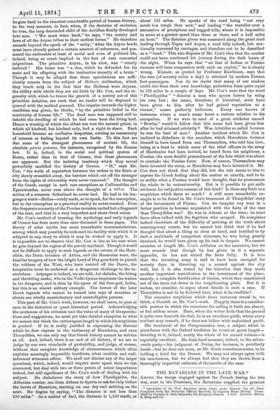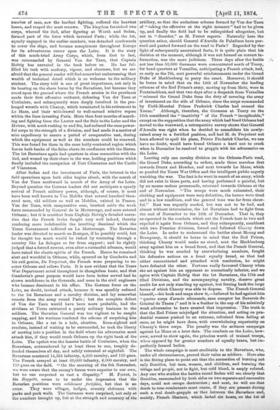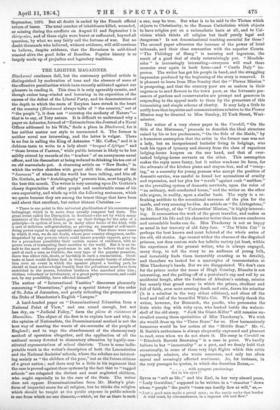THE BAVARIANS IN THE LATE WAR.* AMONG the troops engaged
against the French during the late war, next to the Prussians, the Bavarians supplied the greatest
• Operation,' of (he First Bavarian Army Corp, under General Von der Tann. Compiled from the Bavarian Official Records, by Captain Hugo Helvliv. Trans- lated by Captain G. Sails Schawbe, 6th Dragoon Guards. 2 vols. London: Henry S. Sing and Co.
number of men, saw the hardest fighting, suffered the heaviest losses, and reaped the most renown. The kingdom furnished two corps, whereof the 2nd, after figuring at Worth and Sedan, formed part of the force which invested Paris ; while the 1st, equally engaged in the earlier combats, was detached southwards to cover the siege, and became conspicuous throughout Europe for its adventurous career upon the Loire. It is the story of this much-tried Army Corps, which, from first to last, was commanded by General Von der Tann, that Captain Helvig has narrated in the book before us. He has ful- filled his task with modesty, vigour, and clearness, but we are afraid that the general reader will find somewhat embarrassing that wealth of technical detail which is so welcome to the military student. The story told is one of great importance, not only in its bearing on the share borne by the Bavarians, but because they stood upon the ground where the French armies in the provinces made their first offensive outburst, defeating Von der Tann at Coulmiers, and subsequently were deeply involved in the pro- longed wrestle with Chanzy, which terminated in his retirement to Le Mans, and their withdrawal to well-earned relative repose within the lines investing Paris. More than four months of march- ing and fighting from the Lauter and the Sulz to the Loire and the Huisne, with much rushing to and fro, bad reduced the once power- ful corps to the strength of a division, and had made it a matter of wise expediency to ensure a period of comparative rest, during which the equipment as well as the numbers could be renewed. This was found for them in the once hotly-contested region which lies on both banks of the Seine above its confluence with the Marne. The 1st Bavarians again had quarters in close connection with the 2nd, and wound up their share in the war, holding positions which finally included the occupation of Fort Charenton and the Castle of Vincennes.
After Sedan and the investment of Paris, the interest in the field operations upon both sides begins afresh, with the march of Von der Tann southward in search of the Army of the Loire. Beyond question the German leaders did not anticipate a speedy revival of French military power, although, of course, it must have been well known to Von Moltke that several hundred thou- sand men, old soldiers as well as Mobiles, existed in France. Von der Tann, with comparative ease, brushed aside the weak force commanded by General de la Motterouge, and soon entered Orleans ; but it is manifest from Captain Helvig's detailed narra- tive that the French levies fought very well indeed, thereby rendering more indefensible the insulting dismissal which the Tours Government inflicted on La Motterouge. The Bavarian leader was directed to march on Bourges, if he possibly could, but he thought too much would be risked by venturing through a country like La Sologue so far from support ; and he rightly judged that a forced retreat, even after a successful advance, would have raised the elastic spirits of the French. Hence he remained alert and watchful in Orleans, while, spurred on by Gambetta and his evil genius, De Freycinet, the French were preparing to re- cover Orleans and relieve Paris. It is now evident that the Tours War Department acted throughout in thoughtless baste, and that Gambetta's great purpose would have been better served had he shown confidence in the Generals, and none in the civil engineers who became dominant in his office. The German force on the Loire, no doubt, invited attack, because it was speedily reduced to the let Bavarians and a cavalry division, and lay somewhat remote from the army round Paris ; but the complete defeat of Von der Tann would have been more probable, had the civilians at Tours entrusted a purely military business to the soldiers. The Bavarian General was too vigilant to be caught napping, and his wariness rendered the scheme of surprising him in Orleans, like a rat in a hole, abortive. Keen-sighted and resolute, instead of waiting to be surrounded, he took the liberty of moving into a position in the field where his adversaries must attack him, if they would reach Orleans up the right bank of the Loire. The upshot was the famous battle of Coulmiers, when the Bavarians, outnumbered by at least three to one, toughly de- fended themselves all day, and safely retreated at nightfall. The Bavarians mustered 14,534 infantry, 4,450 cavalry, and 110 guns. The French arrayed at least 60,000 infantry, 6,000 cavalry, and 150 guns on the field. " On the morning of the 9th November, we were aware that the enemy's forces were superior to our own, but no one suspected so vast a disparity." M. Perrot, in his Rappo'n, seems to be under the impression that the Bavarian positions were solidement fortifiles, but that is an
error. They were villages, hedges, country châteaux with parks and park walls. The Germans were surprised, not only at the numbers brought up, but at the strength and accuracy of the
artillery, so that the audacious scheme formed by Von der Tann of " taking the offensive at the right moment" had to be given up, and finally the field had to be relinquished altogether, but not in " disorder," as M. Perrot reports. Naturally here the question arises, should General d'Aurelle de Paladines have pur- sued and pushed forward on the road to Paris ? Regarded by the- light of subsequently ascertained facts, it is quite plain that his decision at the moment, although it was not formed on correct in- formation, was the more judicious. Three days after the battle• not leas than 50,000 Germans were concentrated north of Toury, for head-quarters at Versailles, anticipating a French attack, had, as early as the 7th, sent powerful reinforcements under the Grand Duke of Mecklenburg to parry the onset. Moreover, it should be borne in mind that on the 14th of November the leading columns of the Red Prince's army, moving up from Metz, were in Fontainebleau, and that two days after a despatch from Versailles " released the Grand Duke from the duty of covering the army of investment on the side of Orleans, since the corps commanded by Field-Marshal Prince Frederick Charles had crossed the Yonne." Although, therefore, the Germans at Toury on the 12th considered the " inactivity " of the French " inexplicable," except on the supposition that the army which had freed Orleans bad moved to the westward, a retrospective survey shows that General d'Aurelle was right when he decided to consolidate his newly- raised army in a fortified position, and bad M. de Freycinet not been allowed to spoil his plans, Prince Frederick Charles, we can have no doubt, would have found Orleans a hard nut to crack when in December he resolved to grapple with his adversaries on• the Loire.
Leaving only one cavalry division on the Orleans-Paris road, the Grand Duke, according to orders, made those marches first towards Dreux and Houdan, and next towards Le Mane, which so puzzled the Tours War Office and the intelligent public eagerly watching the war. The fact is he went in search of an army, which did not exist in those parts, and having performed a painful, but by no means useless promenade, returned towards Orleans at the end of November. "The troops were much exhausted, their clothing and equipment were very defective, the horses were tired and in a low condition, and the general tone was far from cheer- ful." Rest was urgently needed, but was not to be had, and almost without intermission, the 1st Bavarians had to fight from the end of November to the 10th of December. That is, they co-operated in the combats which cut the French host in two and expelled it -again from Orleans, and they subsequently, combined with two Prussian divisions, forced and followed Chanzy down. the Loire. In order to understand the battles about Meuug and Beaugency, it should be borne in mind that the Red Prince, thinking Chanzy would make no stand, sent the Mecklenburg army against him on a broad front, and that the French General, thinking he was assailed by overwhelming numbers, fought his defensive actions on a front equally broad, so that had either concentrated and attacked with resolution, he might have defeated the other. Fortune really favoured Chanzy when she set against him an opponent so numerically inferior, and we- agree with Captain Helvig that the 1st Bavarians, the 17th and 22nd Divisions, and the accompanying cavalry, deserve great credit for not only standing up against, but forcing back the large forces of which Chanzy was able to dispose. The French General himself,—his book and maps show it,—believed he had against him "quatre corps d'armde allemande, sans compter les Bavarois du- General de Thanu ;" and it is a feather in the cap of his relatively weak adversaries to have created that impression. The truth is. that the Red Prince misjudged the situation, and acting on pru- dential reasons pushed to an extreme, refrained from falling at once, as he might have done, with overwhelming superiority on Chanzy's three corps. The penalty was the arduous campaign against Le Mans at a later date. The combats on the Loire, how- ever, served to show again, the priceless worth of trained troops, when opposed by far greater numbers of equally brave, but im- perfectly formed bodies.
The whole campaign is most creditable to the Bavarians, who, under all circumstances, proved their value as soldiers. Here also is the fitting place to point out that the accusation of burning not only Bazeiiles, but men, women, and children, and burning the village and pe-,ple, not in fight, but cold blood, is amply refuted.. Any one who studies the battles round Sedan will see clearly that Bazeilles, cannonaded by both sides on two separate and successive days, could not escape destruction ; and next, he will see that death to non-combatants must ensue, if they are present during such a real death-grapple as that between the Bavarians and, mainly, French Marines, which lasted six hours, on the 1st of September, 1870. But all doubt is ended by the French official return of losses. The total number of inhabitants killed, wounded, or missing during the conflicts on August 31 and September 1 is thirty-nine, and of these eight were burnt or suffocated, beyond all question, by what we may fairly call the fortune of war. But no doubt thousands who believed, without evidence, will still continue to believe, despite evidence, that the Bavarians in cold-blood roasted alive the good folks of Bazeilles. Popular history is so largely made up of prejudice and legendary tradition.




































 Previous page
Previous page